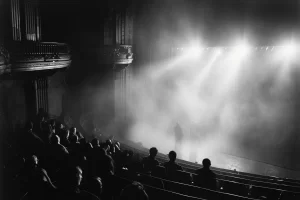The Haunted Tampa Theatre

The city of Tampa, Florida crawls with ghosts, from the spirit of a drunken Cuban man rumored to haunt the old Florida Brewery Company to the apparition of a ghostly greyhound bus above the Sunshine Skyway Bridge. Tampa harbors ghosts in mundane, unexpected places, such as the municipal parking garage of Fort Brooks, as well as more obvious places, like the Tampa Theatre on North Franklin Street. They say every theatre has its ghosts, and the Tampa Theatre is no exception. The theatre is rumored to be haunted by a whole host of guests from the other side, including a chain-smoking projectionist, a 107-year-old organist, and a dapper, mysterious ghost known only as “fedora man.” Think you’re brave enough for a night at the haunted Tampa theatre? Read on to find out!
History and Background
The year is 1926. You’re standing outside the newly minted Tampa Theatre, a fabulous, towering movie palace glittering with lights and crowded with important people. And for just 25 cents a night, you can be one of them. The interior of the theatre is just as stunning as the exterior, decorated with extravagant art deco light fixtures, plush red velvet seats, and ornately carved replicas of Grecian busts keeping watch through eyes of stone.
The reality of the Tampa Theatre more than lived up to the grand vision of Paramount Pictures when they commissioned the design from prominent Chicago-based architect John Eberson. In the 1920s, motion pictures were fast becoming the most popular and accessible form of entertainment for Americans, and millions of men, women, and children flocked to the magnetic pull of the silver screen week after week. As the demand for larger and more grandiose movie palaces came rolling in, John Eberson quickly made a name for himself.
Eberson was known for designing elaborate, atmospheric theatres, and the Tampa Theatre quickly became his most exciting design yet. When completed, the single stage of the Tampa Theatre mimicked the experience of sitting in a courtyard beneath a twinkling sky of stars, complete with clay rooftops, gargoyles, and tangled vines against a glowing blue backdrop. Eberson’s design teleported audience members to another time and place, truly exemplifying the escapism of moviegoing in the 20th century. Audiences paid for an experience, and an experience they would get.
For decades, the Tampa Theatre raked in the dough. The 1930s saw an unpreceded boom in ticket sales, as Americans struggling to stay afloat during the Great Depression succumbed to an increasingly greater need for escapism. The 40s saw a similar need for escape during the war. But by the 1950s, movie mania had begun to cool. In the wake of WWII, American families began migrating to the suburb in droves, devastating the many downtown businesses that had become dependent on their financial support. Along with this shift, the advent and popularization of television provided stiff competition for the already stalling film industry. As audience numbers dwindled, the Tampa Theatre fought in vain to keep up with the ever-rising costs of staying in business.
By the early 1970s, the once-great movie palace was slated for demolition. But the citizens of Tampa refused to stand for this. In 1973, the community rallied around their beloved theatre and struck a deal with the Tampa City Council to purchase the building and ensure its preservation. Renovations began the following year, and in 1977, the Tampa Theatre reopened with all the splendor and grandeur of 1926. In 1978, the theatre officially landed on the National Register of Historic Places and was designed a Tampa City Landmark a decade later.
More: Could one of the city’s most beloved landmarks also be its most haunted?
Today, the story of how Tampa saved its Theatre has become a celebrated success story and a kind of model for saving and persevering historic places. The theatre is currently managed by the nonprofit organization the Tampa Theatre Foundation, and hosts over 600 events a year in its single auditorium. These events fall under a wide range of categories, including new releases, classic films, live performances, tours, and educational seminars. Where it once struggled to stay in business, the Tampa Theatre has now welcomed over five million guests inside its ornately carved doors and remains a testament to the remarkable spirit of the citizens of Tampa. According to legend, many of these citizens enjoy a night at the movies so much that they’ve decided never to leave. Under the faux night sky of the Tampa Theatre, a whole cast list of undead characters patiently awaits the inevitable dimming of the lights, signaling their cue to come out and play among the living.
Haunted Happenings
First up on the list of Tampa Theatre poltergeists is the pesky chain-smoking spirit of Foster “Fink” Finley. Fink worked as a projectionist at the theatre until he died of a heart attack in 1965 inside the very booth where he worked. But many guests and employees believe Fink never left. According to his contemporaries, Fink only took the job to watch free movies and has continued this hobby well into the afterlife. Over the years, patrons seated in the back row by the projection room have made complaints about cigarette smoke, even though the theatre has banned smoking for decades. Other visitors have reported hearing loud, boisterous laughter followed by a heavy smoker’s cough coming from the projection room.
One employee recounts another strange tale involving the late Fink Finley. He claims he was cleaning the theatre late one night after a midnight showing when he saw something strange up in the projection room. Unable to make out what it was, he set down his broom and started up the plush stairs to investigate. When he reached the top, the man peered through the glass and noticed a thick cloud of cigarette smoke swirling through the air.
“Hey, who’s in there?” he shouted, assuming the culprit must have been a group of teenagers sneaking into the back to smoke cigarettes. But no one answered. Puzzled, he tentatively unlocked the projection room and threw open the door to reveal an empty room. As the thick clouds of smoke escaped into the theatre, the employee swears he saw them form into the shape of an old man with a cigarette hanging from his mouth. As the tip of the ghostly cigarette glowed red the apparition winked, then vanished. The theatre considers the wink as positive a review as any.
Joining Fink Finley at the theatre is the ghost of organist Rosa Rio. When the theatre opened in 1926, films were a silent affair. Enter the Mighty Wurlitzer, a massive 1,400-pipe organ whose powerful sound more than matched the excitement of the screen. The Mighty Wurlitzer enjoyed its fair share of performances, but by the 1930s the addition of sound had forced it into retirement. Fifty years later, the organ was reinstated as part of the city’s renovation efforts, and the theatre hired accomplished musician Rosa Rio to play it. For decades, Rosa played the organ with pride, filling the massive audition with haunting melodies night after night. She was so passionate about the instrument that not even death could keep them apart. In 2010, Rosa passed away at the ripe old age of 2007, but many patrons and employees of the theatre believe she never stopped coming into work.
One patron recalls an especially hair-raising tale involving the late organ player. After catching a late-night movie with her boyfriend, the woman left the theatre and realized she had forgotten her purse inside. Swearing, the woman ducked back inside to retrieve it. As soon as she entered, the chilling tones of an organ being played stopped her in her tracks.
The haunting, ominous notes reverberated through the whole room, sending chills up the woman’s spine. Even more spine-tingling, there appeared to be no one playing it! The woman watched in terror as the massive instrument’s many keys and pedals rose up and down of their own accord. She was so terrified she immediately fled the theatre, forgetting her purse entirely.
Last but certainly not least of the Tampa Theatre’s many ghosts is the infamously well-dressed spirit of “fedora man.” According to long-term employees and patrons of the theatre, the spirit most often materializes in seat 308. Many employees have reported looking into the audience after hours and spotting the shadowy figure of a man in a suit and hat. When addressed, the figure vanishes into thin air. Out of respect for fedora man, the theatre reserves seat 308 for special performances.
Whether you’re in the mood for a classic film or a summer blockbuster, the Tampa Theatre has it all. The theatre also hosts haunted happenings from top to bottom, from the smoky apparition of Fink Finley in the projection room to the organ-playing spirit of Rosa Rio in the orchestral pit, designating the Tampa Theatre as a certified favorite among cinephiles and paranormal enthusiasts alike.
Next: Top 10 Haunted Places in Tampa
Sources:
https://tampamagazines.com/inside-the-haunted-tampa-theatre/
https://tampatheatre.org/about/history/
https://www.visittampabay.com/listings/tampa-theatre/8911/
https://www.baynews9.com/fl/tampa/news/2020/10/16/tampa-bay-s-10-most-haunted
